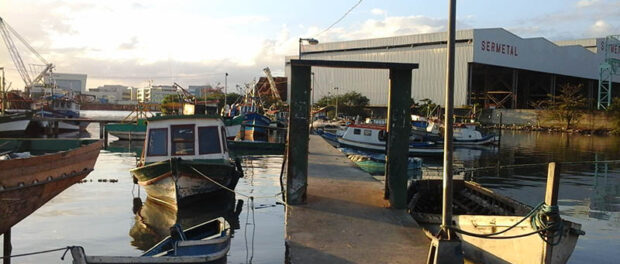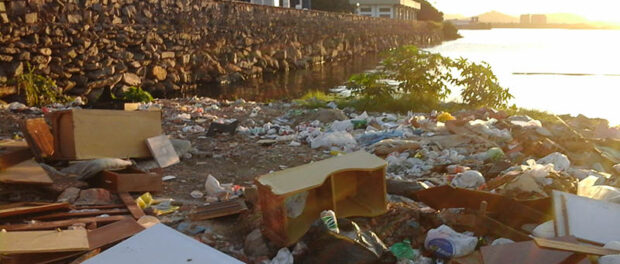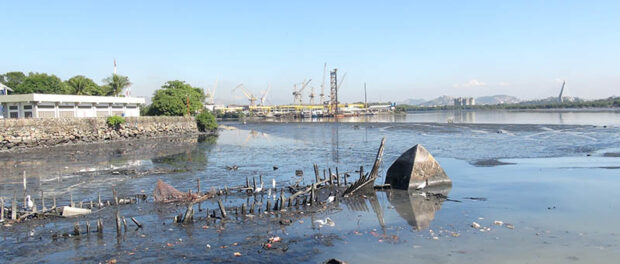
For the original by Clarisse Werneck, Daniela Pereira and Ricardo Costa in Portuguese, published in Viva Favela, click here.
Whoever looks at the small dozen boats moored at the beach of Caju, amongst the sea of rubbish and mud, will find it difficult to imagine that this place prospered in the 60s and 70s as the main fishing colony of Rio de Janeiro. The decadence of the current settlements Z-12 and Z-5 is a result of various factors. Among them the rivalry of industrial fishing, the pollution of the Guanabara Bay and the industrialization of the area. However, in the memories of its veterans, tales of a period when fish were abundant and the sea crystal clear live on. The rare remaining active fishermen, now in their third or fourth generation, also witnessed the rapid impoverishment of the region as the city established the port area.
Claudio Luiz Marques, 57, is one of them. Known as “Baixinho,” he has worked for more than 40 years as a fisherman in Caju. In the heyday of the colony, he would catch between 100 and 200 kilos of fish from each trip out. Today, Claudio rents his boat out for recreational fishing. “If fishing had worked out I would have taught everything I know to my son. But there is no future in fishing. I don’t want my son in this profession,” he says.
Claudio believes the closing down of the fish market in Praça XV in the 90s is the reason for the failure of traditional fishing. In the old market, each fisherman sold his fish whereas today he offloads his goods in Ceasa (a central deposit for resale) or in the fish market of São Pedro in Niterói, into the hands of middlemen. “I have to pay for the journey, the refrigeration, pay the boat staff, all the debts. With a big boat, it allows you to fish many tons. But with a small or medium-sized boat you don’t earn anything,” explains Claudio. “We used to have the life of kings. Today, one kilo of sardines isn’t even worth R$1! Who is going to stay out at sea two, three days to earn 80 cents for a kilo of fish?”
The sea is not for fish
Environmental degradation is, however, the main cause for the decline of the profession. “This rubbish which you see piled up in the colony comes from the canals of Cunha and Jacaré, which flow into the bay,” says Gilberto Gouveia Monteiro, a mechanic who works on maintenance of the boats. Gilberto is part of the small group of Caju residents who, in spite of the difficulties, manage to make a living from fishing. They still practice traditional fishing in the area known as Varal in Quinta do Caju–which today is part of the Z-5 community–with about three small boats (for two people or a fisherman and his helper) and two mid-sized boats (which could hold around 15 workers).
According to the mechanic, another problem which plagues the community is mud. When the sea level drops, it stops the boats from leaving and arriving. The phenomenon started with the building of industries and dockyards in the surrounding area. The dredging of access canals to the bay to make them deeper allowing the navigation of deep draft boats, left mud deposits forming real underground ravines. The mud gets carried into the colony by the tide.
Gilberto went as far as researching what would be necessary for a revitalization of the colony. “Who knew it here in the past and sees it today would cry,” he laments. According to him, there are condemned structures that need to be restored urgently, like a concrete ramp with exposed ironwork that is likely to collapse.
“These structures present a risk to the lives of the fishermen who pass over it,” he warns.
From fishing town to industrial town
The fishing colony of Caju was born at the end of the 19th century, when families from Póvoa do Varzim in Portugal migrated to make their fortune in Brazil. In the streets of the neighborhood some pine wood houses, today crumbling, are remnants of this heritage. Over the years, the colony prospered until becoming, in the mid-50s and 60s, the largest of the city. It was also a no less important trading center for fish, an activity which ended with the creation the fish market in Praça XV by SUDEPE (the Superintendent for the Development of Fishing) in the 30s.
In the 80s, rapid industrialization of the region resulted in unchecked growth of its population. The sleepy fishing colony of Caju became the area with the highest concentration of favelas in Rio de Janeiro, currently accounting for eight. According to data from the 2010 census, 79% of the area’s population (almost 16,000 people) lives in favelas. The numbers also reveal that in the space of 10 years, from the year 2000 to 2010, the population of Caju grew at more than double the average rate for the city (16% against 7%).
Quinta do Caju, which had 52,000 square meters dedicated to fishing, lost 80% of its area over the course of 30 years when they installed the Electronic Aviation Materials Park (PAME RJ) and the biggest dockyard in the country, the Ishikawajima (or Ishibras). “In the past, we had more than 100 boats fishing here. We had a shop for nets, a clinic, a line to hang up the nets. Fishermen were happy. Today we can barely work,” Gilberto says.
Two ecological disasters instigated the decline of the profession: the creation of the Duque de Caxias landfill site, which destroyed the mangrove area–the main marine fauna nursery of the bay–and the leakage of the Petrobras pipeline in 2000, recorded as one of the biggest environmental accidents of the country. “When I began to fish, the water at the Rio-Niteroi bridge was clean and crystal clear,” reminisces a friend of Claudio who doesn’t wish to be identified. He remembers the accident well, which directly impacted the profession, “The riverbed was completely worthless, there was a complete wipeout of birds as well as fish,” he says.
The ex-fisherman, who now earns a living as a doorman, is proof of the economic importance the activity had in the region, “The sea was my way of life. I got married with the money I earned fishing. I raised and married my children. They are educated. The house I have today, I built with the money I earned on the boats. So, the sea means a lot to me!’ he reveals.


